Country life: celebrating the rich creative cache of Sussex modernists

Two Temple Place, a late Victorian mansion built by William Waldorf Astor on the north bank of the Thames, is one of London’s lesser known architectural gems – and lesser known galleries. Until April, its grand, eccentrically embellished halls will be filled with paintings, poems, furniture, photographs, sound installations, scale models, films and paraphernalia from the Sussex Modernists. They comprise Sussex Modernism: Retreat and Rebellion', the most interdisciplinary exhibition the space has staged in its six years promoting culture.
For curator Hope Wolf, a lecturer in British modernist literature at the University of Sussex, including all these different disciplines is essential to understanding the diverse group. But pulling together such an eclectic exhibition was no mean feat. Wolf mined local archives and enlisted contacts in nine galleries and museum-houses across Sussex.
The objects she uncovered plot a visual history of the region. We discover that in the first half of the 20th century, the rolling hills of provincial East and West Sussex became unlikely hives of creative activity. Artists, craftsmen and writers escaped metropolitan London for the rural idylls and farmhouses that were to become cultural epicentres. 'I was keen to question why these people went to Sussex, what they thought of it, or whether they were interested in it at all,' explains Wolf.

’Divine Lovers’, by Eric Gill, 1923.
We begin our countryside ramble in Ditchling, near Brighton, where a Catholic craft community advocating working by hand was founded in 1920. The most famous member was sculptor and typographer Eric Gill. Here, we see his blending of religious iconography and eroticism through a series of sketches and sculptures. The posthumous revelations surrounding Gill’s reprehensible sexual proclivities has created a serious ethical dilemma for curators, and marred the idea of Sussex as a utopian retreat.
Nonetheless, the Ditchling group's desire to merge utility with art provides a solid basis on which to build our picture of the Sussex modernists. Unlike these patriarchal craftsmen (they did not allow female members), the Bloomsbury group was feminist and progressive – and both were working concurrently, less than half an hour's drive down the road. Charleston, the rural home of London's intellectual set, marks our next Sussex stop. It is represented by a selection of paintings and murals by Duncan Grant and Vanessa Bell, including a powerful nativity scene for which local Sussex farmhands served as models.
From here we journey onward through the South Downs and coastline, past staggering works by John Piper, Pablo Picasso and Edward Wadsworth to painter Peggy Angus’ cottage Furlongs and collector Edward James' extravagant Monkton House. Displayed in the original glass-fronted wall cabinets of Two Temple Place, their works couldn't look more at home, and visitors are transported back in time. We sense the political undertones of the period bubbling away behind the glass – like in the Angus sketch of a reclining nude reading The Crisis of Capitalist Culture with a wry smile, never before shown in public.

’Mae West’s Lips’ sofa, by Salvador Dalí, 1938, commissioned by Edward James.
To fit in the extensive range of works, Wolf has made use of every space in the building, including its fanciful stairway, replete with ornate balustrades and newels. Here, the red 'Mae West's Lips' sofa, commissioned by Edward James and designed by Salvador Dalí in 1938, juxtaposes with the dark wood of the staircase.
But at the top of the stairs we are transported into a modernist world that seems a million miles away from this decadence. Humble and quiet, Farley Farm House (near the delightful-sounding village of Muddles Green) was home to photographer Lee Miller and surrealist artist Roland Penrose. For 35 years, from 1949, their kitchen table hosted many renowned international guests – notably Picasso, Joan Miró and László Moholy-Nagy, whose photographs of the modernist De La Warr Pavilion are displayed here next to its impressive scale model.
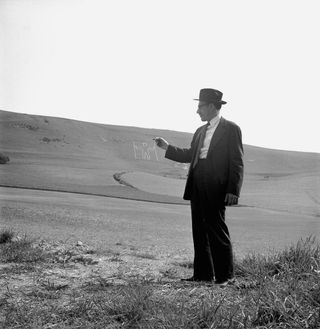
’Steinberg added the finishing touches to the Long Man of Wilmington, East Sussex, England’, by Lee Miller, 2016.
Like the Hungarian Moholy-Nagy, many influential artists were attracted to Sussex from overseas. Indeed, Wolf was surprised to discover just how many émigrés appeared in the region in the early twentieth century – German-Jewish Erich Mendelsohn and Russian-born Serge Chermayeff, for example. Not everyone, it seems, was escaping the British capital; they were escaping war-torn mainland Europe, too.
In places, Sussex is just as close to the French coastline as it is to London, affording it a unique vantage point for war time artistic documentary. In The Times, Virginia Woolf described hearing bombs fall on France from the South Downs as 'the beating of gigantic carpets by gigantic women'. The immediacy the English writer depicts gives the whole region a sense of creative claustrophobia.
So much pioneering, problematic art was being produced, and in such close proximity. Wolf describes it as a 'visual cacophony'. The curator teases out connections and synergies between these interrelated communities, creating a coherent path through the region's cultural history. Nonetheless, she has left many questions unanswered, for the audience to draw their own conclusions. Whether the Sussex modernists were rebelling, retreating or simply relocating, Wolf believes it may take 'any number of future exhibitions' to fully understand. This insightful exhibition offers plenty to keep us going until then.
Wallpaper* Newsletter
Receive our daily digest of inspiration, escapism and design stories from around the world direct to your inbox
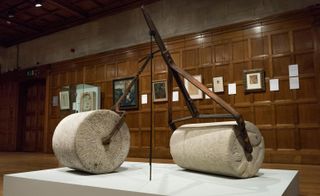
The arts and crafts movement of Ditchling, in Sussex, advocated working by hand
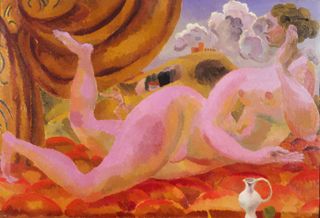
Venus and Adonis, Duncan Grant, c1919.

Two Temple Place's original glass-fronted cabinets are used to display works

Beach and Star Fish – Seven Sisters Cliff Eastbourne, by John Piper, 1933–34.
INFORMATION
’Sussex Modernism: Retreat and Rebellion’ is on view until 23 April. For more information, visit the Two Temple Place website
ADDRESS
Two Temple Place
2 Temple Place
London WC2R 3BD
Elly Parsons is the Digital Editor of Wallpaper*, where she oversees Wallpaper.com and its social platforms. She has been with the brand since 2015 in various roles, spending time as digital writer – specialising in art, technology and contemporary culture – and as deputy digital editor. She was shortlisted for a PPA Award in 2017, has written extensively for many publications, and has contributed to three books. She is a guest lecturer in digital journalism at Goldsmiths University, London, where she also holds a masters degree in creative writing. Now, her main areas of expertise include content strategy, audience engagement, and social media.
-
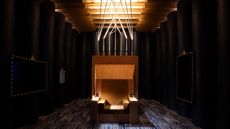 David Lynch presents 'A Thinking Room' at the Salone del Mobile
David Lynch presents 'A Thinking Room' at the Salone del MobileHere's a first look at the David Lynch Salone del Mobile 2024 installation, a cinematic experience within the fair curated by Antonio Monda
By Laura May Todd Published
-
 Riva El-Iseo is the legendary boat builder’s first fully-electric motor yacht
Riva El-Iseo is the legendary boat builder’s first fully-electric motor yachtThe Riva El-Iseo electric speedboat blends classic Italian lines with a silent, powerful and zero-emission powertrain
By Jonathan Bell Published
-
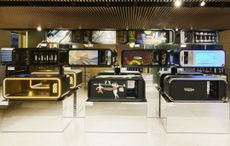 Technogym Home Bench 40 ways: designers interpret the home exercise classic
Technogym Home Bench 40 ways: designers interpret the home exercise classicTechnogym marks its 40 anniversary with 40 special editions of its Home Bench created in collaboration with international creatives
By Rosa Bertoli Published
-
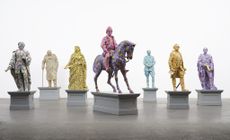 Yinka Shonibare considers the tangled relationship between Africa and Europe at Serpentine South
Yinka Shonibare considers the tangled relationship between Africa and Europe at Serpentine SouthYinka Shonibare‘s ‘Suspended States’ at Serpentine South, London, considers history, refuge and humanitarian support (until 1 September 2024)
By Tianna Williams Published
-
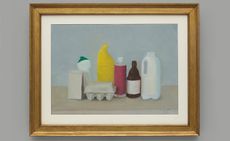 Gavin Turk subverts still-life painting and says: ‘We are what we throw away’
Gavin Turk subverts still-life painting and says: ‘We are what we throw away’Gavin Turk considers wasteful consumer culture in ‘The Conspiracy of Blindness’ at Ben Brown Fine Arts, London
By Rowland Bagnall Published
-
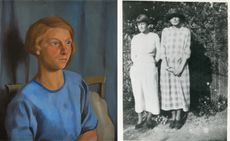 Dorothy Hepworth and Patricia Preece: Bloomsbury’s untold story
Dorothy Hepworth and Patricia Preece: Bloomsbury’s untold story‘Dorothy Hepworth and Patricia Preece: An Untold Story’ is a new exhibition at Charleston in Lewes, UK, that charts the duo's creative legacy
By Katie Tobin Published
-
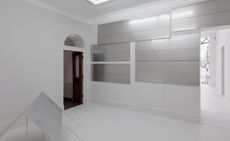 Don’t miss: Thea Djordjadze’s site-specific sculptures in London
Don’t miss: Thea Djordjadze’s site-specific sculptures in LondonThea Djordjadze’s ‘framing yours making mine’ at Sprüth Magers, London, is an exercise in restraint
By Hannah Silver Published
-
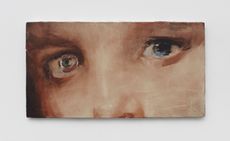 ‘Accordion Fields’ at Lisson Gallery unites painters inspired by London
‘Accordion Fields’ at Lisson Gallery unites painters inspired by London‘Accordian Fields’ at Lisson Gallery is a group show looking at painting linked to London
By Amah-Rose Abrams Published
-
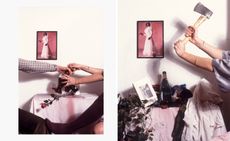 Fetishism, violence and desire: Alexis Hunter in London
Fetishism, violence and desire: Alexis Hunter in London‘Alexis Hunter: 10 Seconds’ at London's Richard Saltoun Gallery focuses on the artist’s work from the 1970s, disrupting sexual stereotypes
By Hannah Silver Published
-
 Wayne McGregor’s new work merges genetic code, AI and choreography
Wayne McGregor’s new work merges genetic code, AI and choreographyCompany Wayne McGregor has collaborated with Google Arts & Culture Lab on a series of works, ‘Autobiography (v95 and v96)’, at Sadler’s Wells (12 – 13 March 2024)
By Rachael Moloney Published
-
 Danielle Brathwaite-Shirley confronts gaming, VR and rebirth at Studio Voltaire
Danielle Brathwaite-Shirley confronts gaming, VR and rebirth at Studio VoltaireDanielle Brathwaite-Shirley has opened her first institutional solo exhibition, ‘THE REBIRTHING ROOM’, at Studio Voltaire, London
By Hannah Silver Published